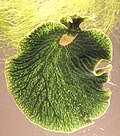Chloroplast capture is an evolutionary process through which inter-species hybridization and subsequent backcrosses yield a plant with new genetic combination... 3 KB (336 words) - 17:41, 3 January 2024 |
constructed for African Americans, Latino/Hispanics, and Uyghurs. Chloroplast capture Gene cluster Gene flow Haplogroup Human genetic variation Hybrid... 7 KB (729 words) - 01:02, 4 January 2024 |
 | Photosynthetic pigment (redirect from Pigments in Chloroplast) (accessory pigment; chloroplast pigment; antenna pigment) is a pigment that is present in chloroplasts or photosynthetic bacteria and captures the light energy... 4 KB (383 words) - 05:14, 27 January 2024 |
 | based on nuclear and cytoplasmic DNA analyses can be explained by chloroplast capture, as similar inconsistencies have been explained by this phenomenon... 12 KB (1,240 words) - 20:20, 27 April 2024 |
 | botany, refers to the colorless fluid surrounding the grana within the chloroplast. Within the stroma are grana (stacks of thylakoid), the sub-organelles... 2 KB (197 words) - 22:04, 27 May 2023 |
 | Thylakoids are membrane-bound compartments inside chloroplasts and cyanobacteria. They are the site of the light-dependent reactions of photosynthesis... 37 KB (4,369 words) - 00:37, 13 March 2024 |
 | women. Biology portal Bird hybrid Canid hybrid Chimera (genetics) Chloroplast capture (botany) Eukaryote hybrid genome Endogenous retrovirus Retrovirus... 69 KB (6,903 words) - 22:20, 21 March 2024 |
CoRR hypothesis (section Chloroplasts and mitochondria) bioenergetic organelles". Chloroplasts and mitochondria are energy-converting organelles in the cytoplasm of eukaryotic cells. Chloroplasts in plant cells perform... 10 KB (1,255 words) - 04:18, 1 October 2022 |
 | chloroplasts a part of its own cellular content. The incorporation of chloroplasts within the cells of Elysia chlorotica allows the slug to capture energy... 19 KB (2,187 words) - 23:32, 5 March 2024 |
 | Morgan, Raff, Roberts, and Walter. "Energy Conversion: Mitochondria and Chloroplast." Molecular Biology of the Cell, Sixth Edition By Alberts. 6th ed. New... 8 KB (737 words) - 01:11, 6 August 2023 |
 | confirmed these sections, in addition to discovering a potential chloroplast capture event in Dicerandra immaculata var savannarum. Dicerandra species... 5 KB (550 words) - 16:09, 12 March 2024 |
 | secondary endosymbiosis or ingestion. The capture and sequestering of photosynthetic cells and chloroplasts, kleptoplasty, occurs in many types of modern... 61 KB (6,029 words) - 18:37, 23 April 2024 |
 | are imported to the stromal compartment of chloroplasts from the cytosol by crossing the outer chloroplast membrane. The enzymatically active substrate... 59 KB (6,521 words) - 20:49, 28 April 2024 |
from Latin: bilis meaning "bile") are light-capturing bilins found in cyanobacteria and in the chloroplasts of red algae, glaucophytes and some cryptomonads... 7 KB (725 words) - 05:05, 24 January 2024 |
















